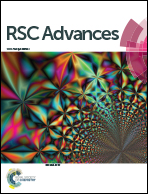Urea-formaldehyde derived porous carbons for adsorption of CO2†
Abstract
The aim of the research work is to develop high nitrogen content carbon adsorbents with high textural and surface properties using as a precursor urea-formaldehyde resin and as a template mesoporous-zeolite (MCM-41) through a nanocasting technique. The material undergoes carbonization followed by physical activation under a CO2 atmosphere to generate different carbon structure adsorbents. Different characterization techniques such as XRD, SEM, TEM, FTIR, CHN, TKN, nitrogen sorption, TGA, TPD and XPS were used for thorough characterization of the samples. XRD and TEM reveal the development of nanostructured carbon adsorbents. CO2 adsorption on adsorbents was investigated between temperatures of 30 and 100 °C and concentrations of 5 to 12.5% in a dynamic fixed bed column to overcome a gap in the literature. The carbon sample prepared at 700 °C through the nanocasting technique shows high basicity and exhibited a high CO2 uptake of 0.84 mmol g−1 with a nitrogen content of 17.18%. It shows higher values at a high adsorption temperature (100 °C) as compared to the literature, which fulfills the objective of this study. An adsorbent prepared at 800 °C shows the highest surface area (337.07 m2 g−1), but shows a lower adsorption capacity as compared to one prepared at 700 °C whose surface area was slightly lower (297.68 m2 g−1). This shows that besides textural and nitrogen content, adsorption capacity depends on nitrogen functionalities. The adsorbents exhibit stability and easy regenerability over four adsorption–desorption cycles with better selectivity for CO2. This was also confirmed from the lower value of Qst (kJ mol−1). The CO2 adsorption kinetics follow a fractional order model with less than 5% error. The equilibrium adsorption data fitted the Freundlich isothermal model well, demonstrating the heterogeneous nature of the adsorbent surface. Thermodynamics suggests a spontaneous, feasible and exothermic process.


 Please wait while we load your content...
Please wait while we load your content...